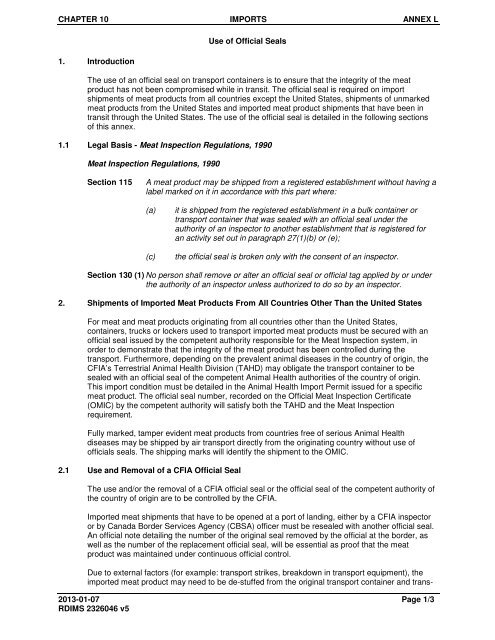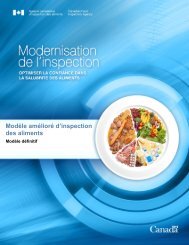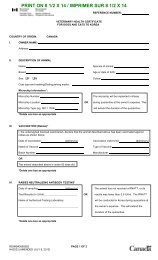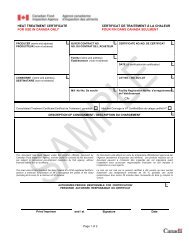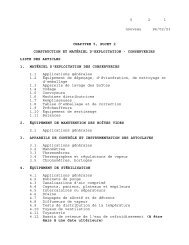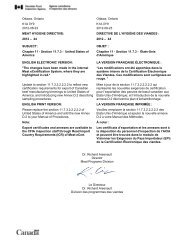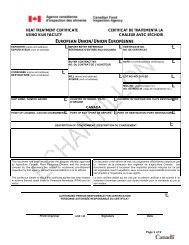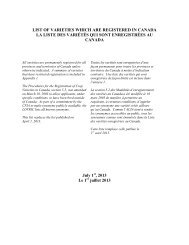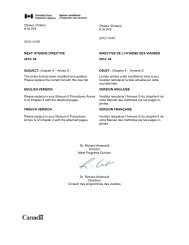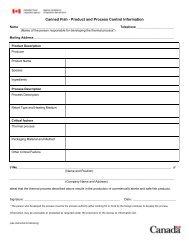PDF (342 kb ) - Agence canadienne d'inspection des aliments
PDF (342 kb ) - Agence canadienne d'inspection des aliments
PDF (342 kb ) - Agence canadienne d'inspection des aliments
You also want an ePaper? Increase the reach of your titles
YUMPU automatically turns print PDFs into web optimized ePapers that Google loves.
CHAPTER 10 IMPORTS ANNEX L1. IntroductionUse of Official SealsThe use of an official seal on transport containers is to ensure that the integrity of the meatproduct has not been compromised while in transit. The official seal is required on importshipments of meat products from all countries except the United States, shipments of unmarkedmeat products from the United States and imported meat product shipments that have been intransit through the United States. The use of the official seal is detailed in the following sectionsof this annex.1.1 Legal Basis - Meat Inspection Regulations, 1990Meat Inspection Regulations, 1990Section 115A meat product may be shipped from a registered establishment without having alabel marked on it in accordance with this part where:(a)(c)it is shipped from the registered establishment in a bulk container ortransport container that was sealed with an official seal under theauthority of an inspector to another establishment that is registered foran activity set out in paragraph 27(1)(b) or (e);the official seal is broken only with the consent of an inspector.Section 130 (1) No person shall remove or alter an official seal or official tag applied by or underthe authority of an inspector unless authorized to do so by an inspector.2. Shipments of Imported Meat Products From All Countries Other Than the United StatesFor meat and meat products originating from all countries other than the United States,containers, trucks or lockers used to transport imported meat products must be secured with anofficial seal issued by the competent authority responsible for the Meat Inspection system, inorder to demonstrate that the integrity of the meat product has been controlled during thetransport. Furthermore, depending on the prevalent animal diseases in the country of origin, theCFIA’s Terrestrial Animal Health Division (TAHD) may obligate the transport container to besealed with an official seal of the competent Animal Health authorities of the country of origin.This import condition must be detailed in the Animal Health Import Permit issued for a specificmeat product. The official seal number, recorded on the Official Meat Inspection Certificate(OMIC) by the competent authority will satisfy both the TAHD and the Meat Inspectionrequirement.Fully marked, tamper evident meat products from countries free of serious Animal Healthdiseases may be shipped by air transport directly from the originating country without use ofofficials seals. The shipping marks will identify the shipment to the OMIC.2.1 Use and Removal of a CFIA Official SealThe use and/or the removal of a CFIA official seal or the official seal of the competent authority ofthe country of origin are to be controlled by the CFIA.Imported meat shipments that have to be opened at a port of landing, either by a CFIA inspectoror by Canada Border Services Agency (CBSA) officer must be resealed with another official seal.An official note detailing the number of the original seal removed by the official at the border, aswell as the number of the replacement official seal, will be essential as proof that the meatproduct was maintained under continuous official control.Due to external factors (for example: transport strikes, breakdown in transport equipment), theimported meat product may need to be de-stuffed from the original transport container and trans-2013-01-07 Page 1/3RDIMS 2326046 v5


